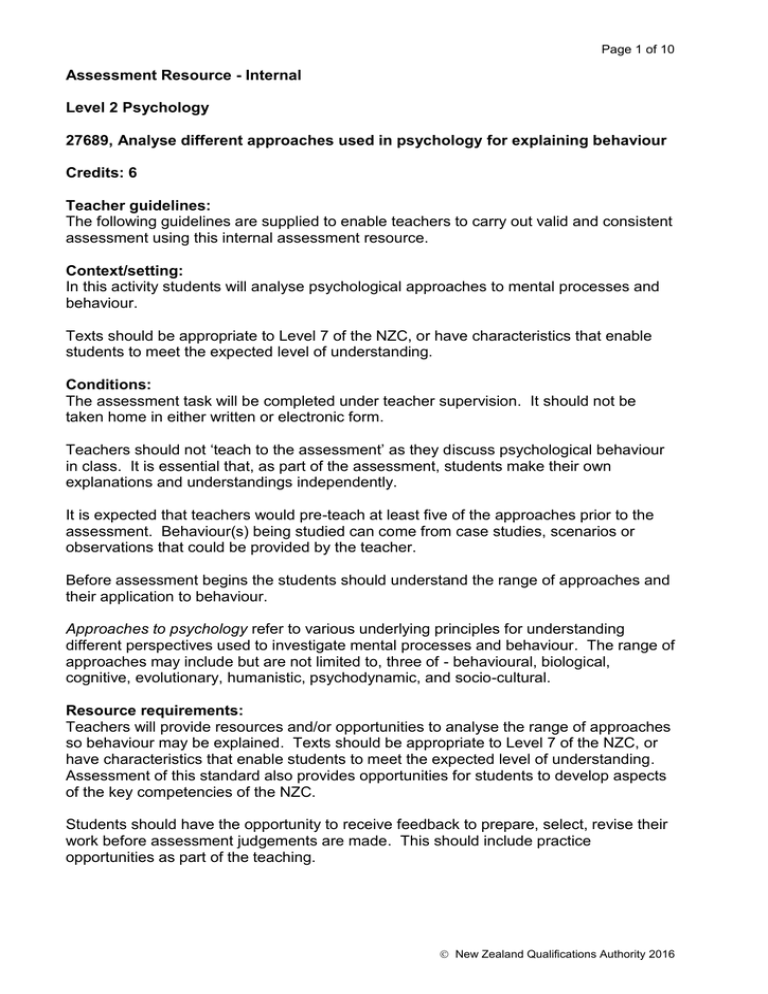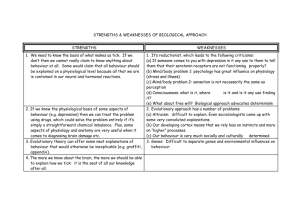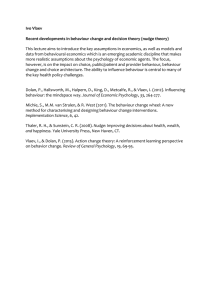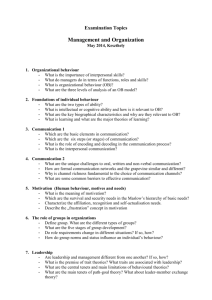Assessment resource (DOC, 111KB)
advertisement

Page 1 of 10 Assessment Resource - Internal Level 2 Psychology 27689, Analyse different approaches used in psychology for explaining behaviour Credits: 6 Teacher guidelines: The following guidelines are supplied to enable teachers to carry out valid and consistent assessment using this internal assessment resource. Context/setting: In this activity students will analyse psychological approaches to mental processes and behaviour. Texts should be appropriate to Level 7 of the NZC, or have characteristics that enable students to meet the expected level of understanding. Conditions: The assessment task will be completed under teacher supervision. It should not be taken home in either written or electronic form. Teachers should not ‘teach to the assessment’ as they discuss psychological behaviour in class. It is essential that, as part of the assessment, students make their own explanations and understandings independently. It is expected that teachers would pre-teach at least five of the approaches prior to the assessment. Behaviour(s) being studied can come from case studies, scenarios or observations that could be provided by the teacher. Before assessment begins the students should understand the range of approaches and their application to behaviour. Approaches to psychology refer to various underlying principles for understanding different perspectives used to investigate mental processes and behaviour. The range of approaches may include but are not limited to, three of - behavioural, biological, cognitive, evolutionary, humanistic, psychodynamic, and socio-cultural. Resource requirements: Teachers will provide resources and/or opportunities to analyse the range of approaches so behaviour may be explained. Texts should be appropriate to Level 7 of the NZC, or have characteristics that enable students to meet the expected level of understanding. Assessment of this standard also provides opportunities for students to develop aspects of the key competencies of the NZC. Students should have the opportunity to receive feedback to prepare, select, revise their work before assessment judgements are made. This should include practice opportunities as part of the teaching. New Zealand Qualifications Authority 2016 Page 2 of 10 Additional information: Teaching and learning guidelines that inform psychology as it is taught in New Zealand can be found at http://www.tki.org.nz/ncea/. Information on psychology as it is practiced in New Zealand is available from the New Zealand Psychological Society, http://www.psychology.org.nz. Information on Māori-focussed psychological research available through Māori and Psychology Research Unit http://www.waikato.ac.nz/wfass/subjects/psychology/mpru/ New Zealand Qualifications Authority 2016 Page 3 of 10 Level 2 Psychology 27689, Analyse different approaches used in psychology Credit: 6 Student Instructions Sheet During your Psychology programme in class, your teacher will work with you on a variety of written, oral, visual and multi-media resources. You will do a wide range of activities in class which will help you. Your teacher will also give you opportunities to analyse distinctive features of approaches in relation to the study of behaviour(s). This will include comparisons between approaches from a range of studies. Opportunity will be given for students to generate explanations of behaviour with supporting theories/evidence. You will choose three psychological approaches and analyse the approaches in a written assessment. For achievement your responses should: Identify and explain behaviours from three approaches. This will involve you identifying and explaining two or more points relevant to three or approaches and identifying and discussing their similarities and differences. For merit or excellence your responses may also: Provide relevant psychological theories/evidence to support your explanations of behaviour. Give supporting theories/evidence that show a level of insight linking the explanations you have given to the identified approach. Choosing approaches In the assessment you will decide which three approaches you will use to analyse the given behaviour(s). Exploring approaches and behaviours As part of your Psychology programme your teacher will provide you with the opportunity to explore at least five approaches and their explanation of behaviour(s). Assessment Guide For achieved For merit For excellence Analyse different approaches used in psychology for explaining behaviour. The analysis includes a comparison of the three explanations of behaviour from different identified approaches, with key points of similarity and difference between the approaches identified and discussed. Supporting psychological theories and evidence must be included in the analysis. The analysis includes a comprehensive comparison of explanations of behaviour with supporting psychological theories and evidence presented that is perceptive, relevant to behaviour, and consistently applied. New Zealand Qualifications Authority 2016 Page 4 of 10 Sample Assessment Read the following scenario and complete the task that follows: Current situation Sarah is a 15 year old who started experiencing problems about 6 months ago. She started showing behaviour swings at school, alternating between being very withdrawn and quiet, to being very loud, displaying a shortness of temper and being verbally abusive, especially to teachers and other staff. These swings have become more frequent and extreme. Whilst previously a very tidy person, she is now producing untidy work and her personal appearance has become scruffy. Sarah has stopped playing sport. She has become attracted to a boy in Year 13 but is too shy to approach him. If they pass in the corridor, Sarah hides her feelings by making loud comments to her friends. She realises that while this may make him notice her, it will not be giving him the impression she wants him to have. Background Sarah is the middle child of three, with an older sister and a younger brother, born to middle income parents. Her father spends a lot of time with his business or out with his friends. When home he is mostly grumpy, but he also has unpredictable periods of being overfriendly. Sarah’s mother also works. She is a quiet woman who is the peacekeeper in the family. Sarah’s mother tries to keep her husband happy as much as possible. She would not ask him to do anything and, as the children got older, stopped asking them to do anything if it was likely to create conflict. Sarah’s mother keeps quiet about any trouble the children are in, including Sarah’s recent behaviours at school. When the children are a problem at home, she would threaten to tell their father, but rarely did so because she could not tell how he would react. Her main fear was that if he was grumpy he would lose his temper and hit the children. There have been problems earlier in the families’ life with CYPF (Children and Young Persons and their Families) making enquiries after an expressed concern from the primary school. At other times, Sarah’s father would just tell the children off, or sometimes say it wasn’t a problem and question why Sarah’s mother is making a fuss. Sarah’s father is not worried about her behaviour at school. He says his daughters from his previous relationship were expelled from school for bullying and teacher abuse and when he got involved with the school to try and sort things out it made no difference. One of the daughters is now a “bouncer” and the other has been a court a number of times for assault. Sarah’s mother says she needs help and that should see a counsellor. Sarah refuses. Sarah’s mother has talked to her doctor to see about a referral to a psychologist. Sarah’s father says Sarah is totally tied up by her own feelings and will grow out of it so other help is a waste of time. No-one, including Sarah, can do anything about her behaviour for now. New Zealand Qualifications Authority 2016 Page 5 of 10 From the scenario complete the following tasks: Behaviour(s) being studied: Here is an exemplar with a partially completed table of a behaviour using information from another case study. Complete the blank tables below this with four chosen behaviours. Use three approaches in each table. Summary of the Behaviour Approach Fourteen year old boy is smoking daily at school. Cognitive Explanation of behaviour by the chosen approach He perceives smoking to be ‘cool’ and believes by engaging in this behaviour he will be seen to fit in with the ‘cool’ group. Psychodynamic Biological Cigarettes contain the drug nicotine, which is an addictive substance. The boy smokes because he has developed dependence or because his dopamine reward Relevant supporting theory/evidence within the approach According to Freud, children go through the Psychosexual Stages of Development. As they move through these stages, pleasure is sought in different areas of the body. Where the child has failed to properly negotiate a stage, fixation may occur. This will lead to stereotyped behaviours being displayed in adult personality. In the oral stage, children must negotiate weaning. If they are weaned too early or too late they may become orally receptive or orally aggressive. Later in life, they will seek pleasure by placing things in their mouths and engage in behaviours such as smoking. Drugs affect the release of neurotransmitters across the synapse, affecting nerve transmission. This in turn can have an effect on behaviour. Drugs of addiction may lead to New Zealand Qualifications Authority 2016 Page 6 of 10 pathway has been activated. withdrawal effects when the drug is not in the system. This will lead an individual to seek the drug to remove the negative effects of withdrawal. Tolerance to the drug may lead to increased consumption to achieve the same effect. The nicotine in cigarettes stimulates the dopamine reward pathway thus creating a pleasurable experience. Summary of Chosen Behaviour One: Approach Explanation of behaviour by the chosen approach Relevant supporting theory/evidence within the approach Summary of Chosen Behaviour Two: Approach Explanation of behaviour by the chosen approach Relevant supporting theory/evidence within the approach New Zealand Qualifications Authority 2016 Page 7 of 10 Summary of Chosen Behaviour Three: Approach Explanation of behaviour by the chosen approach Relevant supporting theory/evidence within the approach Summary of Chosen Behaviour Four: Approach Explanation of behaviour by the chosen approach Relevant supporting theory/evidence within the approach For Achieved your answers should: Identify and explain behaviours from three approaches. This will involve you identifying and explaining two or more points relevant to three or approaches and identifying and discussing their similarities and differences. For merit and excellence your answers could also include You providing relevant psychological theories/evidence to support your explanations of behaviour. This will involve you making three explanations of one behaviour from different approaches, with supporting evidence. The supporting theories/evidence should show a level of perception linking the explanations you have given to the identified approach. New Zealand Qualifications Authority 2016 Assessment schedule 27689, Judgement Statements: Analyse different approaches used in psychology Achieved Achieved with Merit Achieved with Excellence Two points for each of the three approaches are explained correctly. This can be spread across the four tables. Supporting psychological theories/evidence are not required As for achieved, but within any one table three correct explanations are required for a behaviour from different approaches and these explanations are compared. Supporting psychological theories/evidence may not be fully developed. As for merit, but supporting psychological theories/evidence for each of those explanations is perceptive, relevant and consistently applied. 27689 Evidence Statements: Analyse different approaches used in psychology for explaining behaviour Achieved Achieved with Merit Achieved with Excellence Will involve the student identifying and explaining two or more points relevant to three or approaches, with points of similarity and difference discussed. Includes a comparison of the three explanations of behaviour from different identified approaches, with key points of similarity and difference between the approaches identified and discussed. Supporting psychological theories and evidence must be included in the analysis. Includes a comprehensive comparison of explanations of behaviour with supporting psychological theories and evidence presented that is perceptive, relevant to behaviour, and consistently applied. Behaviours may include but are not limited to: behaviour swings, withdrawn/loud, aggression, verbally abusive/swearing, untidiness, lack of care in personal appearance, attraction, shyness. Three correct explanations from the achieved criterion are provided for relevant behaviours. These three explanations are compared with key points of similarity and / or difference between the approaches identified and Explanations of genetic inheritance and it’s application within the biological approach. This could include, but is not limited to: family trees, twin and adoption studies Eg The biological approach places an emphasis on New Zealand Qualifications Authority 2016 Aggression Biological: Sarah’s father and sisters also display aggressive behaviour. This could indicate a genetic predisposition for this behaviour. Other explanations could include but are not limited to: biochemical imbalances eg hormonal imbalances (testosterone), brain structure/functional differences eg amygdala Aggression Cognitive: Sarah does not perceive her behaviour as being innappropriate or aggressive. Her schema of normal behaviour includes treating people aggressively. Aggression Behavioural: Sarah has learnt to behave aggressively through observing her sisters and father being reinforced/rewarded for behaving aggressively. discussed. Supporting theories and evidence to be provided to support the explanations The elements for analysis would be the same as those identified for excellence but would not be a comprehensive comparison. the physical determinance on behaviour. Some studies have found a higher correlation in aggressive behaviour between monozygotic twins than dizygotic twins. McGuffin and Gottesmann (1985) found a concordance rate of 87% for aggressive and antisocial behaviour for MZ twins, compared with 72% for DZ twins. This demonstrates a genetic component in the exhibition of aggressive behaviour. Explanation of schema theory. May relate to concepts of schema theory and Piaget’s research. Eg. Sarah has assimilated the pattern of her father’s aggressive behaviour into her normal behaviour schema. Schemata form the basis of our cognitive framework and mental understanding of the world around us. Our perceptions thoughts and memories can be distorted based on our schema. Sarah’s perception and understanding of her own behaviour will be distorted due to her abnormally developed schema. Explanation of social learning theory. Eg. Behaviourist psychologists state that all behaviour has been learnt through association, reinforcement or vicarious learning. Sarah has seen her father be rewarded by his mother for his aggressive behaviour. Thus making her more likely to imitate his behaviour. This is supported by research such as Bandura’s (1965) Influence of Models Reinforcement Contingencies on Imitative Responses Study (Bobo Doll follow up study). New Zealand Qualifications Authority 2016 Attraction Evolutionary: Sarah is attracted to an older male as a long-term ‘mate’ who will provide the best opportunity for provision of resources which will increase the survival chances of her and her future offspring. Verbal Abuse Psychodynamic: Sarah is orally fixated which means she is displaying orally aggressive behaviour such as verbal abuse and swearing. Explanation of evolutionary theory. Eg. Evolutionary theory suggests that we have adapted our behaviours over time (specifically the Environment of Evolutionary AdaptationEEA) to fit our surroundings. Just like physical adaptation acting within the theory of natural selection. Sarah has become attracted to an older male at school because she views him as an ideal long-term ‘mate’. This means, in evolutionary terms, an older male would be better able to provide for both mother and child through better provision of resources. Eg. According to Freud, children’s experiences form the Psychosexual Stages of Development. Where the child has failed to properly negotiate a stage, fixation may occur. This may lead to stereotyped behaviours being displayed in adult personality. In the oral stage, children must negotiate weaning. If they are weaned too early or too late they may become orally receptive or orally aggressive. An example of orally aggressive behaviour is verbal abuse as demonstrated by Sarah. Notes: Evidence statements are indicative and not exclusive Distinctive points are exclusive to an approach and do not generally apply to a different approach New Zealand Qualifications Authority 2016


